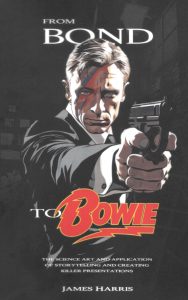The One-Sentence Summary
Using the power of storytelling is the way to make successful presentations.
Can’t be bothered to read it? Listen to the 5-minute summary in two parts.
Want to buy the book? CLICK HERE
WHAT THE BOOK SAYS 
- This book is subtitled The science, art and application of storytelling and creating killer presentations. We live in a world that is defined and delivered by storytelling but despite this few people ever embrace the power of storytelling in the world of work.
- The science behind good storytelling lies in what the author calls cognitive doping – the ability to trigger various neurochemicals in the brain.
- Dopamine creates curiosity, focus and concentration.
- Oxytocin fosters empathy, trust, generosity and bonding.
- Endorphins create joy.
- When you set out to create a narrative, presentation or pitch, these are the triggers you should include. Collectively, they have been described by author JP Philips as the ‘Angel’s Cocktail.’
- When it comes to art, you need a story spine. This has been a critical ingredient in the success of the film production company Pixar and is variously called Pixar Storytelling or the Pixar Way. The format is:
- Once upon a time (describe the situation)
- And everyday (describe the current state of affairs)
- Until one day (enter some kind of disruption)
- And because of that (new outcome or state of affairs – use as many as you need, within reason)
- Until finally (resolution of the issue)
- And ever since (describe the new state of affairs or status quo)
- The book offers a 10-point plan for excellent presentations:
- Begin with some dinosaurs, unicorns and time travel: come up with an intriguing title
- Have no agenda: forget boring lists, just write ‘Three things for today.”
- Start with a story: this is self-explanatory
- Think story, not slides: make one point only per slide
- Three is the magic number: it permeates every aspect of human life
- Welcome Herr Dumpidump: this is Mr. Bump in Norwegian, but you wouldn’t know without seeing the cartoon, so make use of visual imagery as shortcuts.
- Try Trump and Trainspotting: use cultural references to make cultural connections
- Give a font about fonts and colours: standard business fonts are usually boring
- Submarine hides in the sea: do not state the obvious
- One plus one equals zero: a presentation or story has two parts – the content of it and the person who delivers it. If the presenter just reads out a chart, they nullify the power of both.
WHAT’S GOOD ABOUT IT
- An interesting project called Significant Objects bought 200 mundane objects for less than $1.25 each and then sold them online with each now attached to a well-crafted story, and they sold for a total of $8,000, thus verifying the power and value of storytelling.
- When it comes to charts, do not succumb to the Droste Effect. This is named after a Dutch cocoa company where a woman is holding a tray containing an image the same as the one you are seeing, ad infinitum. The analogy refers to charts within charts within charts. They are impenetrable. Don’t use this approach.
- Nothing is perfect. Kintsugi is a Japanese art form that repairs broken pottery with lacquer mixed with gold, silver or platinum. Rather than hiding the cracks as imperfections, it emphasizes and celebrates them as part of the item’s history. This philosophy embraces flaws and offers a metaphor for resilience and acceptance in mending relationships with clients.
WHAT YOU HAVE TO WATCH
- Not much. The book is short but packs in a lot of information.
